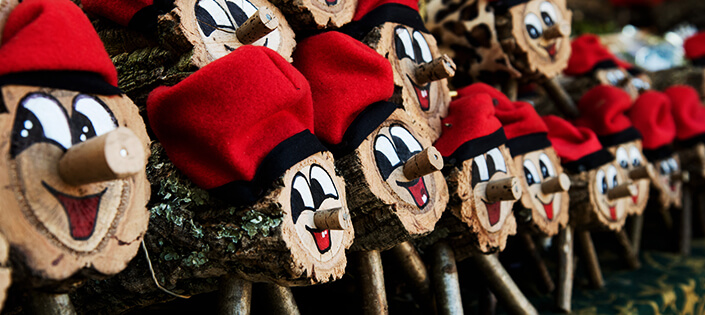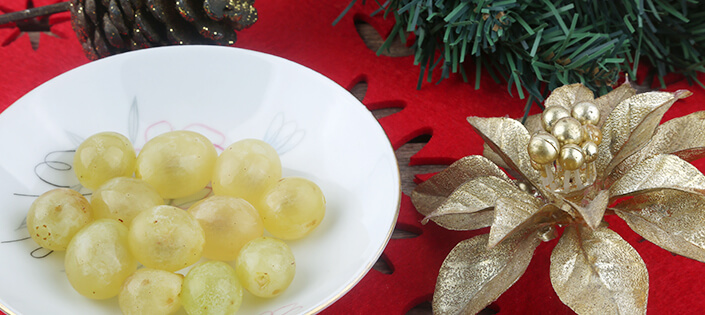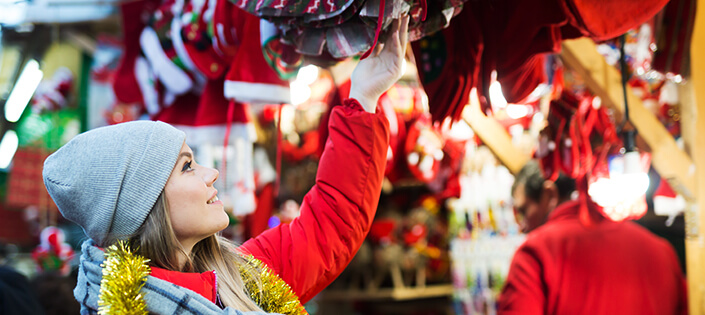
The most magical time of the year is here: it’s Christmas! Spain is known for its warmth, passion, and love for celebration, and during the Christmas festivities, these characteristics shine brightly.
So, here you will find a complete list of all the Christmas traditions in Spain during the holidays. Explore the wonders of Christmas in Spain and fall in love with the country.
1. Nochebuena (Christmas Eve)
In Spain, the celebration of Christmas begins on Nochebuena (Christmas Eve), December 24. This night is spent surrounded by family and friends, as well as copious dinners. In addition, the arrival of Santa Claus is celebrated, a foreign tradition that has spread to Spain, where Santa is called Papá Noel.
The tables are filled with traditional delicacies such as roast lamb, seafood, and nougat. This day is celebrated with family, singing Christmas carols, and exchanging gifts to welcome the beginning of the holidays.
2. Navidad (Christmas Day)
¡Feliz Navidad! December 25, it’s Christmas, another festive day in Spain. Cities are illuminated with twinkling lights and Christmas markets come alive. Also, some regions celebrate with street performances, such as living nativity scenes or choirs singing Christmas carols.
It is a day to stroll through the decorated streets, enjoy the company of loved ones and savour the typical delicacies of the season.
2.1 The Tió de Nadal
In some parts of Spain there are unique traditions such as the Tió de Nadal in Catalonia. It is a trunk with eyes, eyebrows, a nose and two front legs. It is dressed in a blanket, so it doesn’t get cold, and it is crowned with a barretina, a traditional hat in Catalonia.

According to tradition, in the days before Christmas, the little ones of the house must feed the Tió de Nadal to receive the greatest generosity from him. Thus, on December 24, after dinner, the family stands around the trunk and hit the Tió de Nadal with a stick to the rhythm of a popular song.
Thanks to the blows and the song, the Tio de Nadal is “shitting” under the blanket various gifts for everyone. These presents used to be sweets, wafers, or nougat, although nowadays they are usually gifts for the little ones in the house.
2.2 Día de San Esteban (St. Stephen's Day)
On December 26, St. Stephen’s Day is celebrated in some places. This is an extension of Christmas in some regions of Spain such as Catalonia and Balearic Islands, but also in Navarra, Valencia, or Burgos. The festivities continue with family meals, traditional activities, and cultural events. It is a day to continue enjoying the company of loved ones and prolong the magic of Christmas.
3. Día de los Santos Inocentes
Another holiday in Spain, which has nothing to do with Christmas but is celebrated during the same period, is Día de los Santos Inocentes (Holy Innocents' Day). On December 28, Spain celebrates this day, which in other countries is April Fool’s Day, where pranks are played among family or friends.
This day has a unique tradition: playing pranks and jokes. People have fun playing pranks on family, friends and even strangers. It is a day to enjoy and have fun, remembering that sometimes life should not be taken too seriously.
4. Nochevieja (New Year's Eve)
Nochevieja is celebrated on the last night of the year. The most iconic tradition in Spain is the 12 lucky grapes. At midnight, while the clock at Puerta del Sol in Madrid chimes, people eat one grape for each stroke of the clock. There are 12 grapes, one for each month of the year, as this is said to bring good luck for the coming year.

After the grapes, the celebrations continue with fireworks, parties, and dancing until the wee hours of the morning. An entry into the new year in style, bringing together family and friends to welcome a new year and bid farewell to the old one.
5. Cabalgata de Reyes (The Three Kings Parade)
The eve of Three Kings Day, January 5, is one of the most exciting moments for children in Spain. The Three Kings Parade runs through the streets of many cities, with majestic floats carrying the Three Kings, who throw candy to the crowd.
This magical parade marks the arrival of the Three Wise Men and anticipates the morning of January 6, when the Three Kings leave gifts for everyone under the tree.
6. Día de Reyes (Three Kings Day)
Three Kings Day is a much-awaited date by children, as they wake up with the excitement of finding presents left by the Three Kings. If children have behaved well during the year, the Three Wise Men leave gifts. However, if the child has been bad that year, they may find coal under the tree.
In addition, it is common to enjoy the Roscón de Reyes, a typical sweet that is shared with the family. This Christmas sweet is circular, decorated with candied fruit and sugar, and hides a surprise inside: a figurine and a bean. Tradition dictates that whoever finds the figurine receives the king's crown, but whoever discovers the bean pays for the roscón.
These are the best-known festivities in Spain to welcome Christmas. Deep-rooted traditions, catchy songs and gatherings with family and friends.
Let yourself be inspired by the Christmas festivities in Spain and improve your level with an intensive Spanish course. Enjoy Spanish culture to the fullest and discover different cities with unique Christmas traditions at Enforex. Visit our Spanish school in Barcelona and improve your level. ¡Feliz Navidad!
-
 Most beautiful beaches in Spain Beautiful beaches in Spain. Discover the most beautiful beaches in Spain to visit on vacation with Enforex. Most beautiful beaches in Spain.
Most beautiful beaches in Spain Beautiful beaches in Spain. Discover the most beautiful beaches in Spain to visit on vacation with Enforex. Most beautiful beaches in Spain. -
 Spanish Christmas carols Spanish Christmas carols. Improve your vocabulary and learn Christmas songs in Spanish for all levels with Enforex.
Spanish Christmas carols Spanish Christmas carols. Improve your vocabulary and learn Christmas songs in Spanish for all levels with Enforex. -
 Spanish fairy tales Spanish fairy tales. Discover the most popular folk tales in Spanish to practice and continue improving in the language.
Spanish fairy tales Spanish fairy tales. Discover the most popular folk tales in Spanish to practice and continue improving in the language.


